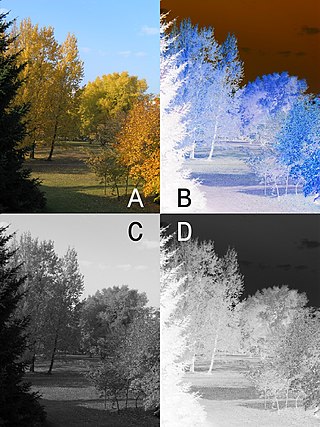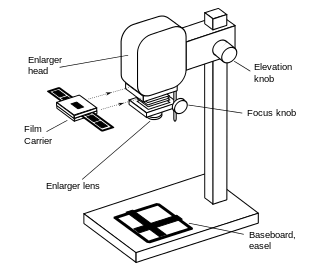Contents
Negative may refer to:
Negative may refer to:

Photography is the art, application, and practice of creating images by recording light, either electronically by means of an image sensor, or chemically by means of a light-sensitive material such as photographic film. It is employed in many fields of science, manufacturing, and business, as well as its more direct uses for art, film and video production, recreational purposes, hobby, and mass communication. A person who captures or takes photographs is called a photographer.
Polar may refer to:

A double negative is a construction occurring when two forms of grammatical negation are used in the same sentence. This is typically used to convey a different shade of meaning from a strictly positive sentence. Multiple negation is the more general term referring to the occurrence of more than one negative in a clause. In some languages, double negatives cancel one another and produce an affirmative; in other languages, doubled negatives intensify the negation. Languages where multiple negatives affirm each other are said to have negative concord or emphatic negation. Lithuanian, Portuguese, Persian, French, Russian, Polish, Bulgarian, Greek, Spanish, Icelandic, Old English, Italian, Afrikaans, and Hebrew are examples of negative-concord languages. This is also true of many vernacular dialects of modern English. Chinese, Latin, German, Dutch, Japanese, Swedish and modern Standard English are examples of languages that do not have negative concord. Typologically, negative concord occurs in a minority of languages.
Positive is a property of positivity and may refer to:

In photography, a negative is an image, usually on a strip or sheet of transparent plastic film, in which the lightest areas of the photographed subject appear darkest and the darkest areas appear lightest. This reversed order occurs because the extremely light-sensitive chemicals a camera film must use to capture an image quickly enough for ordinary picture-taking are darkened, rather than bleached, by exposure to light and subsequent photographic processing.

A darkroom is used to process photographic film, make prints and carry out other associated tasks. It is a room that can be made completely dark to allow the processing of light-sensitive photographic materials, including film and photographic paper. Various equipment is used in the darkroom, including an enlarger, baths containing chemicals, and running water.
Xerography is a dry photocopying technique. Originally called electrophotography, it was renamed xerography—from the Greek roots ξηρόςxeros, meaning "dry" and -γραφία-graphia, meaning "writing"—to emphasize that unlike reproduction techniques then in use such as cyanotype, the process of xerography used no liquid chemicals.

Electrostatic induction, also known as "electrostatic influence" or simply "influence" in Europe and Latin America, is a redistribution of electric charge in an object that is caused by the influence of nearby charges. In the presence of a charged body, an insulated conductor develops a positive charge on one end and a negative charge on the other end. Induction was discovered by British scientist John Canton in 1753 and Swedish professor Johan Carl Wilcke in 1762. Electrostatic generators, such as the Wimshurst machine, the Van de Graaff generator and the electrophorus, use this principle. See also Stephen Gray in this context. Due to induction, the electrostatic potential (voltage) is constant at any point throughout a conductor. Electrostatic induction is also responsible for the attraction of light nonconductive objects, such as balloons, paper or styrofoam scraps, to static electric charges. Electrostatic induction laws apply in dynamic situations as far as the quasistatic approximation is valid.

An enlarger is a specialized transparency projector used to produce photographic prints from film or glass negatives, or from transparencies.

A contact print is a photographic image produced from film; sometimes from a film negative, and sometimes from a film positive or paper negative. In a darkroom an exposed and developed piece of film or photographic paper is placed emulsion side down, in contact with a piece of photographic paper, light is briefly shone through the negative or paper and then the paper is developed to reveal the final print.
Feedback is what occurs when outputs of a system are routed back as inputs as part of a chain of cause-and-effect that forms a circuit or loop.

Compositing is the process or technique of combining visual elements from separate sources into single images, often to create the illusion that all those elements are parts of the same scene. Live-action shooting for compositing is variously called "chroma key", "blue screen", "green screen" and other names. Today, most compositing is achieved through digital image manipulation. Pre-digital compositing techniques, however, go back as far as the trick films of Georges Méliès in the late 19th century, and some are still in use.

"Mongoloid" is the first single released by American new wave band Devo in 1977, on the Booji Boy Records label. It was backed with the song "Jocko Homo". "Mongoloid" also had one of the first music videos made using collage. "Mongoloid" would later be re-recorded by Devo and appeared on the album Q: Are We Not Men? A: We Are Devo! in 1978. It is also a staple of Devo's live shows.
In linguistics, a polarity item is a lexical item that is associated with affirmation or negation. An affirmation is a positive polarity item, abbreviated PPI or AFF. A negation is a negative polarity item, abbreviated NPI or NEG.
Juice is a drink made from the extraction or pressing of the natural liquid contained in fruit and vegetables.
Polarity may refer to:
An internegative is a motion picture film duplicate. It is the color counterpart to an interpositive, in which a low-contrast color image is used as the positive between an original camera negative and a duplicate negative.
Negation is a connective in logic and an operation computing that maps true to false and false to true.
Double Negative may refer to:
In linguistics and grammar, affirmation and negation are ways in which grammar encodes positive and negative polarity into verb phrases, clauses, or other utterances. An affirmative (positive) form is used to express the validity or truth of a basic assertion, while a negative form expresses its falsity. For example, the affirmative sentence "Joe is here" asserts that it is true that Joe is currently located near the speaker. Conversely, the negative sentence "Joe is not here" asserts that it is not true that Joe is currently located near the speaker.